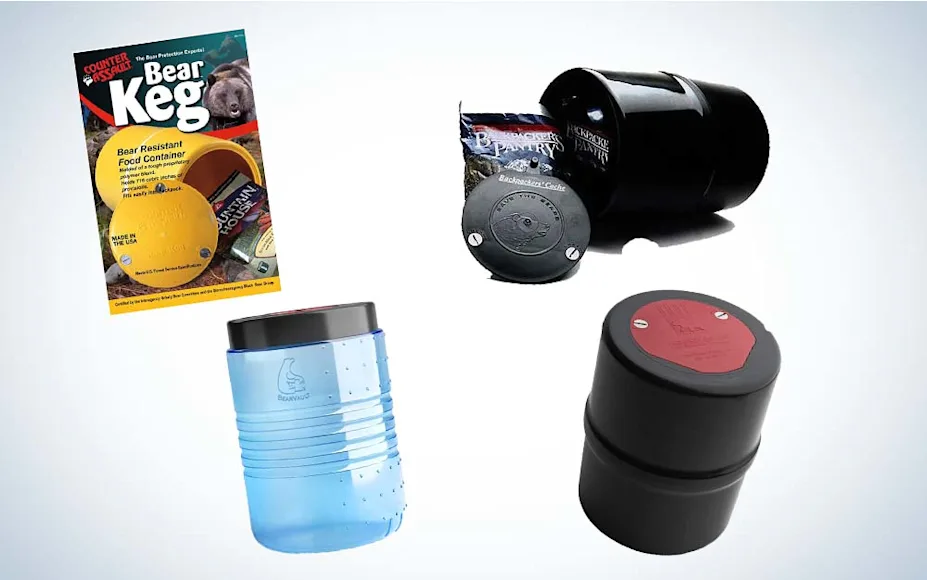_We may earn revenue from the products available on this page and participate in affiliate programs. Learn more ›
_
Best Overall
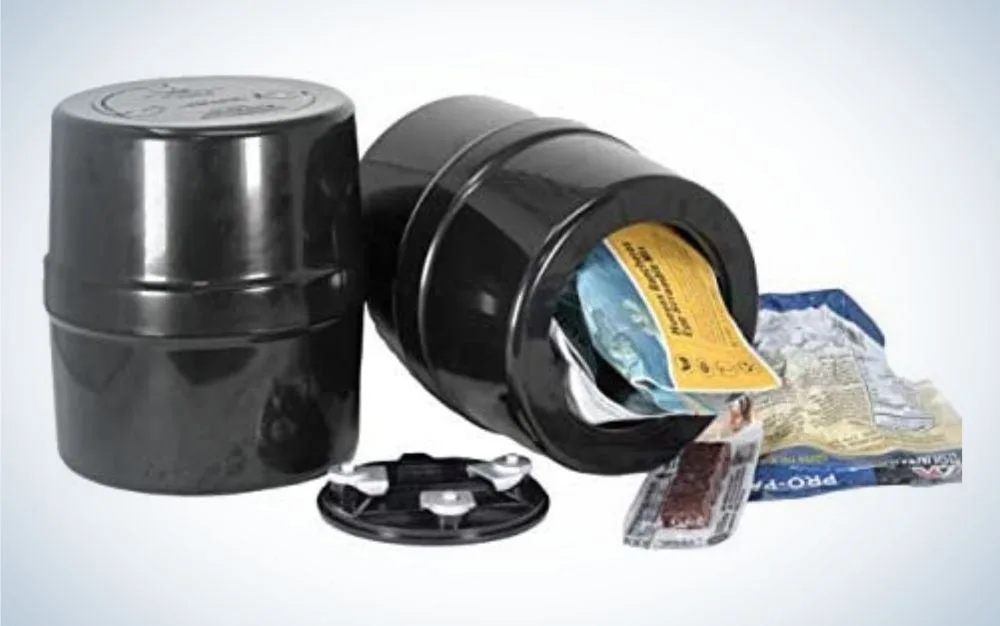
Bare Boxer
LEARN MORE
Summary
The Bare Boxer bear canister is one of the lightest approved bear canisters with a decent carrying capacity and a secure seal.
Most Popular
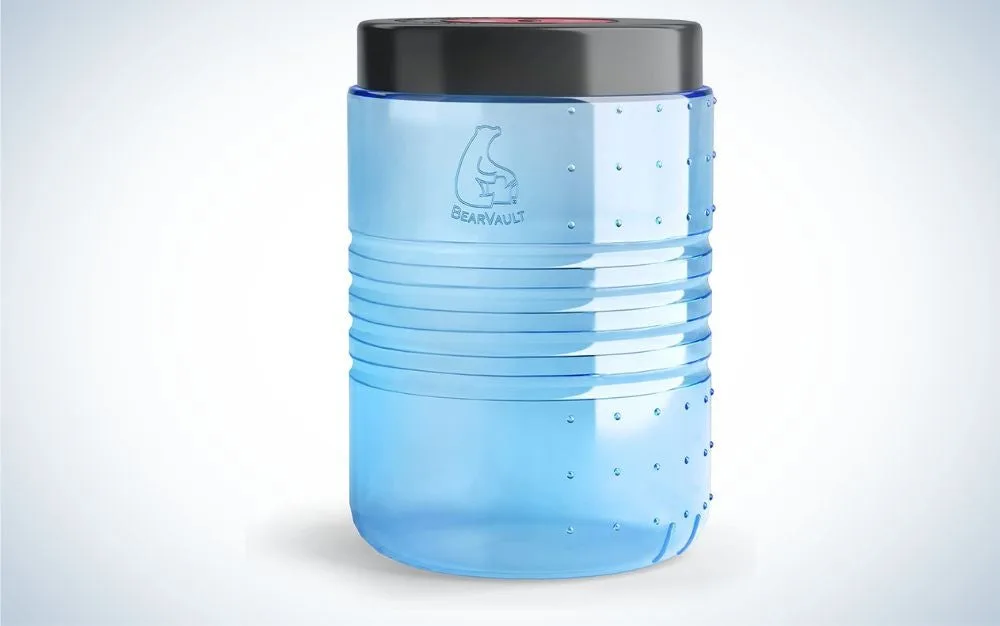
Bearvault BV500
LEARN MORE
Summary
The BearVault canisters are among the most popular on the market with several sizes, transparent materials, and a relatively easy-to-open lid.
Best for Backpacking
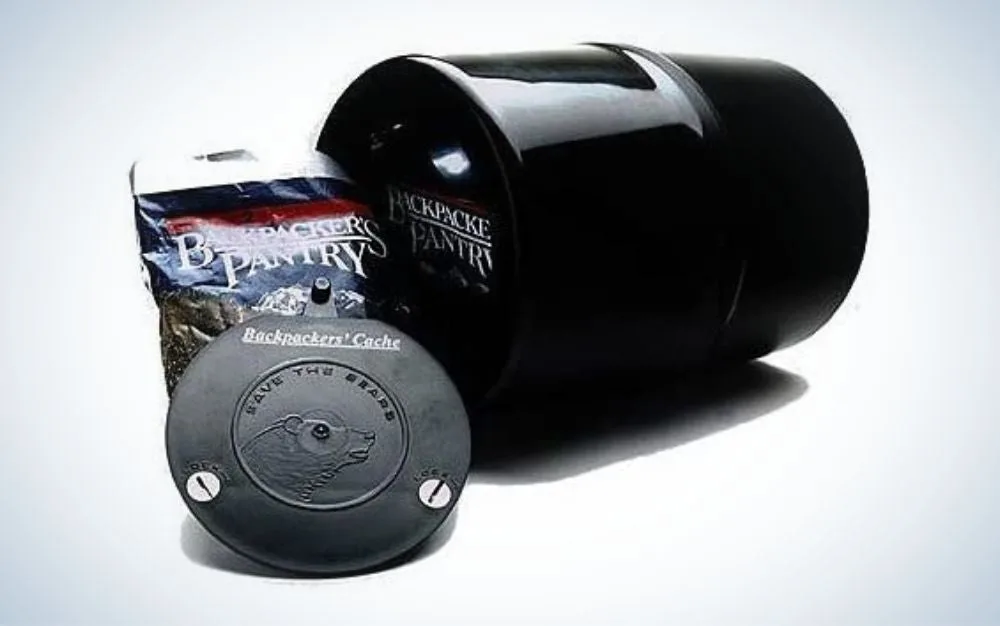
Backpacker’s Cache
LEARN MORE
Summary
The Garcia Backpacker’s Cache is one of the most reliable bear canisters available and is trusted in all parks across the United States.
Bear canisters and bear spray are a few simple ways to stay safe when hiking in bear country. Not everyone likes carrying a bear canister around, but remember, “a fed bear is a dead bear.” So, it is important to be prepared and take the necessary precautions to be safe in the woods.
Carrying a bear canister is not required in all areas, and some locations may favor hanging bear bags or using bear lockers. These are all excellent options when used appropriately. Since not all bear canisters are tested or approved, we put together our top picks for the best bear canisters on the market so you can sleep safely among the bears.
Best Overall: Bare Boxer
Most Popular: Bearvault BV500
Best for Backpacking: Backpacker’s Cache
Best Ultralight: Bearikade Weekender
Most Durable: Counter Assault Bear Keg
Best Budget: UDAP No-Fed Bear Canister
Best Overall: Bare Boxer
Best Overall

Why It Made The Cut: The Bare Boxer bear canister is one of the lightest approved bear canisters with a decent carrying capacity and a secure seal.
Key Features
Weight: 1.6 lbs
Capacity: 3 days
Diameter: 7.4”
Length: 8”
Tool Required: yes
IGBC Approved: yes
Pros
Light and compact
Easy for humans to open, not bears
More affordable than most competitors
Approved for use in all National Parks
Cons
Only holds a 3-day food supply; not suitable for longer trips
Hard to see food inside
The Bare Boxer bear canister is a lightweight bear canister that is suitable for short backpacking trips. The compact container makes it easier to fit into your pack, but it does limit the amount of food it can carry (3-day supply). It requires a key of some kind to open, and it is not sold with one. Luckily, you can use something you probably already carry, like a multitool or pocket knife.
The locking lid makes it more secure and helps to further prevent bears and other animals from accessing the contents. Not everyone likes having to unlock their lid every time they need to get food out, but for a genuinely secure seal, we think it is worth it.
While we love that the materials of this container are durable, the black exterior makes it so you cannot see the contents. A clear container is often easier to use because you can see where items are located instead of having to fish around blindly or remove all of the contents. Despite this, we still think it is one of the best bear canisters on the market, especially for the weekend backpacker.
Most Popular: BearVault
Most Popular

Why It Made The Cut: The BearVault canisters are among the most popular on the market with several sizes, transparent materials, and a relatively easy-to-open lid.
Key Features (BV500)
Weight: 2 lbs 9 oz
Capacity: 7+ days
Diameter: 8.7”
Length: 12.7”
Tool Required: no
IGBC Approved: yes
Pros
Available in 4 sizes
Transparent materials
Large opening for easy access
Can double as a camp stool
Cons
Have been known to fail
Not allowed in the Adirondaks
BearVault bear canisters may be among the most widely used for several reasons, including the transparent materials, which make it easy to see the food you are searching for. It is strong enough to be used as a stool, which is nice to have a seat off the ground in camp. It doesn’t require a tool to open the lid, but it still seals fully. The variety of sizes available is another selling point since you can buy one that fits your particular needs.
Although approved by the IGBC, they are not allowed for use in all areas of the United States. Bears in the Adirondaks
have been known to break through the canister’s materials. However, not all bears are able to do this, which is why it is still approved for use in most areas.
Following proper closure and storage of bear canisters in camp is the best way to avoid a bear accessing anything in the canister. Traveling in high-traffic areas can up your risk of a bear canister failure as bears know where to get food and likely have more practice.
Best for Backpacking: Garcia Backpacker’s Cache
Best for Backpacking

Why It Made The Cut: The Garcia Backpacker’s Cache is one of the most reliable bear canisters available and is trusted in all parks across the United States.
Key Features
Weight: 2 lbs 9 oz
Capacity: 6 days
Diameter: 8.8”
Length: 12”
Tool Required: yes
IGBC Approved: yes
Pros
Can be carried inside or outside a pack
Lid lock isn’t hard for humans to open
Allowed in all areas with bears
Keeps other critters out (raccoons, rodents, etc.) too
Cons
Kind of large and heavy
The Garcia Backpacker’s Cache is among the most trustworthy bear canisters on the market. There are some things we don’t like about it, like the weight and how long it takes to lock and unlock, but for the peace of mind knowing your food is safe, we find it well worth it.
We like the overall size for backpacking, but it may be too big for a single person going on a weekend trip. It is excellent for parties of two or longer adventures. As far as we know, it is allowed in all areas where there is bear activity, and this is because of the low failure rate.
The locking mechanism is on the inside of the lid, and it is recommended that you use a tool like a coin or a knife to unlock it. It is relatively easy for a human to lock and unlock (even if it can be time-consuming), but it seems impossible for animals to open.
Best Ultralight: Bearikade Weekender
Best Ultralight
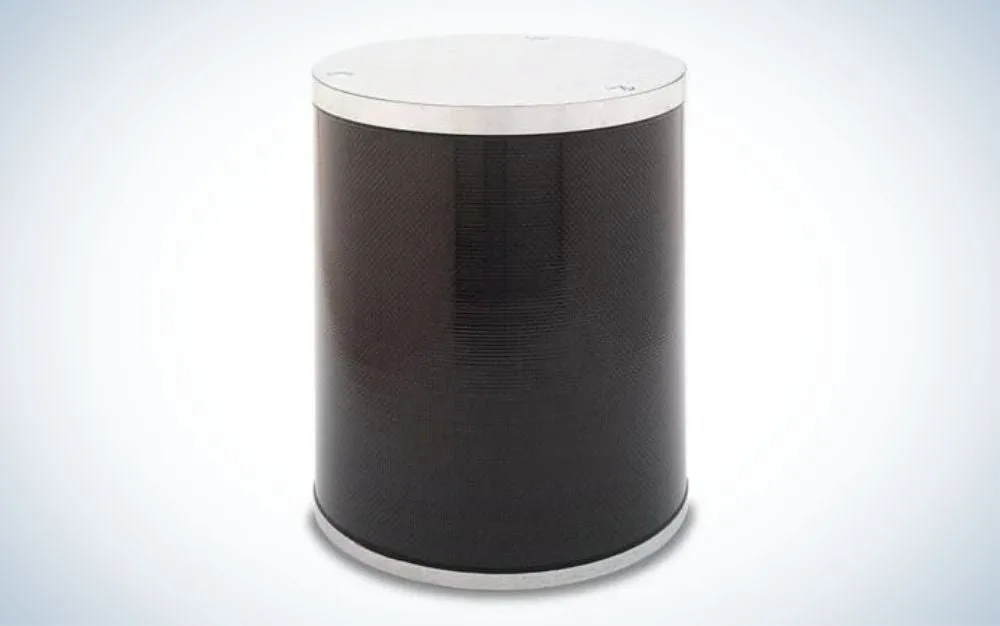
Why It Made The Cut: The Bearikade Weekender bear canister is ultralight and with a strong material strength to weight ratio, making it virtually indestructible.
Key Features
Weight: 31 oz
Capacity: 6 days
Diameter: 9”
Length: 10.5”
Tool Required: Yes
IGBC Approved: No
Pros
Very lightweight
Durable materials
Easy for humans to open
Can be used as a stool
Approved for use by individual parks/locations
Cons
Expensive
Not approved by the IGBC
If weight is the main issue you have with bear canisters, then the Bearikade Weekender should be your top choice. It is made from a lightweight carbon fiber composite sandwich giving it an unbeatable material strength to weight ratio. Although it is not approved by the IGBC yet, it seems indestructible. If you are using this particular bear canister, check with the park regulations to see if it is allowed for use there. Most parks have approved this canister, but without an IGBC approval, not all of them will allow it.
The high price of the canister can be a significant downside, especially since there are approved canisters on the market at a much lower price. Still, the main selling point of this bear canister is that it is so impressively lightweight yet durable.
The weekender name comes from the carrying capacity. It is possible to fit up to 6 days worth of food for one person or a weekend’s worth (3 days) for two people. Since many of us hike in pairs, this makes sense. Despite the high price, we think the overall value of this canister is excellent, especially if you are seeking an ultralight backpacking setup.
Most Durable: Counter Assault Bear Keg
Most Durable

Why It Made The Cut: The Counter Assault Bear Keg is a heavy but durable bear canister you can trust on any adventure.
Key Features
Weight: 3 lbs 10 oz
Capacity: 6-8 days
Diameter: 9”
Length: 14”
Tool Required: Yes
IGBC Approved: Yes
Pros
Visible color
Fits well into a backpack
Carrying case available
Water resistant
Cons
Heavy
We already know you think the Counter Assault Bear Keg is too heavy. It is the heaviest option on our list, but we also believe it is the most durable. If you are looking for extreme durability and something you can truly trust in bear country, the extra weight might be well worth it.
It is an affordable canister, and while it is heavy, it packs easily into most packs. A separate carrying case can be purchased to allow you to carry it outside your pack. To open the canister, a tool is required, which we prefer when it comes to bear canisters. Opening the canister isn’t difficult, but it takes a little time.
Other than the weight, the only potential complaint users may have for this canister is that it isn’t transparent. This can usually be overlooked by most since the canister itself is so reliable and bear-resistant. Plus, the capacity works well for shorter trips with two people or longer solo trips as it holds anywhere from 6-8 days worth of food for one person.
Best Budget: UDAP No-Fed Bear Canister
Best Budget
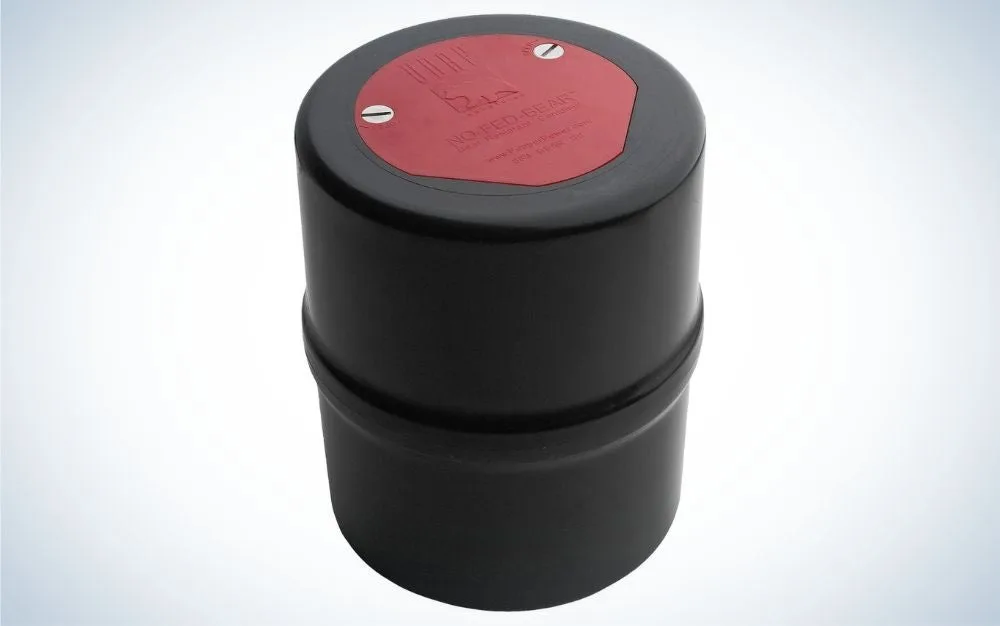
Why It Made The Cut: The UDAP No-Fed Bear Canister is an affordable, approved canister that you can trust.
Key Features
Weight: 2 lbs 13 oz
Capacity: 4 days
Diameter: 8”
Length: 10”
Tool Required: Yes
IGBC Approved: Yes
Pros
Smaller size is easy to pack
Affordable in comparison to similar canisters
Durable construction
Secure lid locks
Cons
Water resistant but not water tight on the lid
Difficult to remove the lid
UDAP makes one of the best bear sprays
, so it is no surprise that the UDAP No-Fed Bear Canister is a top performing approved canister. It is smaller than many other options, but it is perfect for short trips, especially for one person.
Compared to other canisters of similar durability, it is relatively affordable. It isn’t necessarily the cheapest option out there, but in terms of the value, we think it is the best budget option. The smaller size is lovely for packing and won’t weigh you down too much.
While the lid locks securely, the pins can wear out over time and may need to be replaced if you use the canister often. The canister is mostly waterproof, but the lid is not watertight, so be aware of where you store the canister in wet conditions.
Things to Consider Before Buying a Bear Canister
Not all bear canisters are created equal, and not all of them will fit your specific backcountry needs. So, to help you narrow down your choices, consider the following.
Approved and Tested
Even tested bear canisters are not always approved by parks or the Interagency Grizzly Bear Committee (IGBC)
. While all of the other considerations below are important, having one that is approved and tested is essential. Also note that even if the IGBC approves a bear canister, that doesn’t mean that every national park approves of it. National parks with bear activity note on their websites what their bear protocols and safety guidelines are. Always reference each park to ensure that your canister is appropriate for that area. These lists change over time. New canisters can be added and old ones can be removed. Check the listings every time you venture into the parks.
If you do not adhere to the guidelines and approvals provided by the parks and the IGBC, you are subject to fines by park rangers. Worse, you may be exposing bears and humans to dangerous situations that were likely preventable.
Size and Weight
The size and weight of the bear canister are up to the person carrying it. Most hikers prefer to have a canister that isn’t too bulky or too heavy, but it still needs to have enough room to carry all of the necessary items. When hiking in a group, a larger canister may be used so gear can be split up more evenly between all party members. Even the lightest weight bear canisters will seem bulkier than simply carrying your food in your pack. That is part of why we included various sizes, weights, and shapes on our list.
Personal preference with packing also comes into play. Some people may prefer the taller, skinnier canisters, while others gravitate towards more traditional, wider-mouthed ones. Whatever the size and weight you choose, make sure that it fits your needs and is safe for use in your travel areas.
Food Accessibility
One of the most common complaints about bear canisters is how difficult it is to get the food out, but isn’t that the point of the canister? Still, it can be frustrating to get to camp after a long day on the trail, only to struggle for 15 minutes to access your food.
Opening the canister can differ from brand to brand, and some canisters require a tool of some kind to be opened (usually a washer or a coin). Having a lid with several screws can be time-consuming to open and close. There are a few canisters that require no tools for opening, but these tend to be slightly less secure.
Access issues don’t only arise from opening the canister, though. Since not all canisters are see-through, it’s hard to know or remember where in the canister you packed what, meaning you have to take everything out each time to need something. Canisters with wider openings are also easier to get things out of when you are hungry. The tall and skinny canisters may be easy to pack into your backpack, but they can be difficult to fish out the food you want.
Bear Canister vs. Bear Bag
Should you use a bear canister or a bear bag? This question either comes down to area regulations and personal preference. Both options have pros and cons, and neither is 100% bearproof, but they can be effective when used correctly.
Both bear bags and bear canisters are designed to prevent the bear from accessing the food. While some sources online may tell you that it helps to hide the smell of the food from bears, this is not true. Bears can smell through bear canisters and bags. The goal is to make the food inaccessible or at least inconvenient enough to keep the bear from eating it. The way they do this is what differs.
Bear canisters are a container used to hold food and other smellable items. It needs to be stored away from the campsite on the ground in bushes or rocks and should be impossible for a bear to open.
Bear bags can either be a bearproof bag or simply a bag used to store food and other smellables. To keep it away from bears, you hang it in a tree or on a designated bear pole provided by the park.
The primary benefit of using a bear canister is that you don’t have to fuss with finding a location to hang a bag safely. Plus, this means they can be used when camping above treelines or in areas that don’t have much to offer for hanging locations. Still, these canisters can be very bulky and cumbersome to carry long distances.
Bear bags tend to be smaller and lighter to transport, but they can be a real pain to hang up. Since bear canisters are stored on the ground, getting food in and out is easier. Bear bags must be put up and taken down whenever you need something, which can get annoying.
Having a specialty-made bear bag is ideal because the materials tend to be stronger than if you are to use something like a stuff sack. Even the toughest bear bags will be destroyed if a bear gets a hold of the bag. So, the best option is to learn how to properly hang the bags so the bear can never access them. Bear bags may not always be waterproof, which can pose an issue if your food gets wet during a rain storm.
Both bear canisters and bear bags are excellent options for keeping your food away from bears. To decide which option is best for you, first be aware of area regulations and if bear canisters are required. If so, that is the only option. Then, figure out if a bear bag is feasible or not. Will there be places to hang it? Lastly, determine which pros and cons mean the most to you and base your decision on personal preferences or experiences.
Renting vs. Buying a Bear Canister
Did you know that you can rent bear canisters when you travel? This makes things much easier, especially if you are flying in for a hike! Many national parks and even some national forests have bear canisters available to rent for your trip. This not only makes it easier on your pocketbook and cuts down on luggage while you travel, but it ensures that the canister you are using is approved by both the IGBC and the park you are visiting.
Since bear canisters are almost exclusively made from plastic materials, it is also the most sustainable option to rent, especially if you only need a bear canister a couple of times a year.
FAQs
Q: Which bear canisters are the best?
The best bear canisters are the ones that work. So, when choosing a bear canister, always look for ones that have been tested and approved by the Interagency Grizzly Bear Committee and the park you are visiting.
Q: Which bear canisters are approved?
Even if a canister is approved by the IGBC, it may not be allowed in every National Park. Always check to see which canisters are approved by individual parks and areas before you go. You can get fined for having the incorrect canisters. Plus, there’s likely a reason they are not allowed in those parks (in most cases, it’s because bears have gotten into them). To find this information, check out the IGBC-approved product list
as well as the website for the park you plan to visit.
Q: Is a bear canister worth it?
Yes, a bear canister is worth it. In some places, using a bear bag may be more efficient than carrying a bear canister, but some areas require the use of a canister for the safety of the wildlife and the visitors. Not all bear canisters are as effective as others, so be extra aware while shopping for one.
Q: How big of a bear canister do I need?
How big of a bear canister you need depends on the size of your group and the number of nights you plan to be gone. More than food needs to be put into the canister, so be aware of the space required to pack food, toiletries, and other smellable items. Generally, 100 cubic inches (1.6L) is enough room for a day’s worth of food. So, if you have a canister like the BearVault 450, which has a capacity of 440 cubic inches, that should be enough room for 4 days worth of food plus other smellables for one person.
Q: Can bears smell food in a bear canister?
Yes, bears can smell the food in a bear canister. They are not designed to mask the smell of the food or other contents to keep the bear out of them. Canisters are designed to be difficult to open or break, preventing the bear from consuming your food. To help mask the smell, utilize odor-proof bags inside the canister. Even with the use of those bags, though, bears can likely still smell the contents.
Q: How do you use a bear canister?
According to the National Park Service
, store all food, trash, toiletries, and other odorous items inside an IGBC approved bear canister. While asleep or out of camp, store the canister no less than 100 yards downwind from your tent on the ground in some brush or rocks. Avoid putting the canister near a cliff or a water source. Bears have been known to break into canisters by rolling them off hills and cliffs. Always keep the canister closed and locked when food is not in use, even when you are in camp.
Anytime a bear canister isn’t actively used, it should be closed with the lid locked. Bears have been known to enter camps and take open canisters even when humans are in the camp. There is a higher risk of something like this happening if you travel in highly trafficked areas.
Final Thoughts
A big part of keeping you and wildlife safe when in the backcountry has to do with knowing how to prevent encounters in the first place. When traveling through bear country, leaving food out and available will attract animals of all kinds and often bears. While bear bags and boxes are both excellent options, a bear canister may be required in certain areas. When that is the case, invest in the best bear canisters possible, and know how to use them.
Methodology
The number one way we chose the canisters from our list is by following the International Grizzly Bear Committee recommendations and approvals. Other considerations were made along the way, including:
Durability: a bear canister needs to withstand a bear, so it better be durable. If there was any history of failure with those canisters, it was cut from the list, or it was moved to a ranking that better suited it.
Portability: the size and weight of the canisters were all considered. We included a variety of weights and sizes to help you find the right fit for your needs.
Versatility: while all of the canisters on our list should work for most locations, we were careful to include canisters that are approved in all or most national parks. The canister’s size and weight also play into how versatile the canister is for all expeditions. Some canisters may also be used as stools, which improves their versatility.
Other factors such as personal experience with products, verified customer reviews, and company-specific research were also considered.

